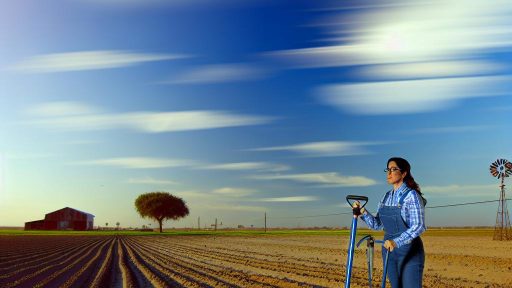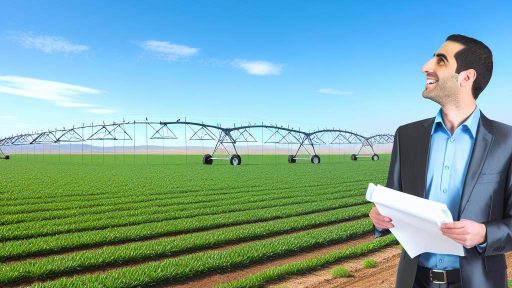Introduction to Climate Risks in Agriculture
Climate change poses significant risks to agriculture around the world.
Farmers face challenges from extreme weather events and shifting climatic patterns.
These changes directly impact crop yields and livestock production.
As a result, farmers experience economic pressures that can affect their livelihoods.
Effects of Climate Change on Crop Production
Higher temperatures can reduce the growing season for certain crops.
In addition, increased drought conditions can lead to water scarcity.
Consequently, many farmers struggle to maintain productivity levels.
This lowers their income and affects food supply chains.
Influence on Livestock Operations
Changes in climate can alter grazing patterns for livestock.
Heat stress affects animal health and productivity.
Low-quality forage impacts livestock growth and milk production.
This can significantly increase operational costs for farmers.
Broader Economic Implications
The agricultural sector plays a critical role in global economies.
Losses in crop yields can drive up food prices for consumers.
Moreover, increased volatility can deter investment in agriculture.
Transform Your Agribusiness
Unlock your farm's potential with expert advice tailored to your needs. Get actionable steps that drive real results.
Get StartedThis may lead to wider economic instability in rural communities.
Understanding the Concept of Climate Resilience
Defining Climate Resilience
Climate resilience refers to the ability of farmers to adapt to changing climate conditions.
This concept encompasses various strategies that help mitigate climate risks.
Farmers can develop resilience through sustainable practices and innovative technologies.
Overall, it aims to maintain productivity despite climate-related challenges.
Importance for Farmers
Climate resilience is crucial for safeguarding agricultural yields.
It helps farmers minimize losses from extreme weather events.
Moreover, resilience enhances food security for local communities.
Farmers equipped with resilient practices can reduce their dependency on external resources.
Financial stability increases as sustainable practices yield better long-term results.
Strategies for Building Resilience
Farmers can adopt several strategies to build climate resilience.
- Diversifying crop varieties improves adaptability to varying conditions.
- Implementing water conservation techniques conserves vital resources.
- Utilizing soil health practices enhances land productivity.
- Engaging in community-based planning strengthens support networks.
These methods collectively contribute to a more resilient agricultural system.
Real-World Examples
Farmers around the globe implement resilience strategies effectively.
For example, in California, farmers use drought-resistant crop varieties.
In Kenya, farmers practice agroforestry to combat soil erosion.
These examples illustrate how adaptability leads to enhanced resilience.
Benefits Beyond Agriculture
Building climate resilience has wider societal benefits.
It supports rural economies by creating job opportunities.
Additionally, it fosters biodiversity and healthier ecosystems.
Cultivating climate resilience also empowers communities to face future challenges.
Economic Strategies for Risk Assessment
Introduction to Risk Assessment Tools
Farmers face numerous climate risks affecting their livelihoods.
Utilizing economic strategies can help assess and mitigate these risks.
Various tools and frameworks exist for effective evaluation.
Data Collection and Analysis
Collecting accurate data is essential for informed decision-making.
Showcase Your Farming Business
Publish your professional farming services profile on our blog for a one-time fee of $200 and reach a dedicated audience of farmers and agribusiness owners.
Publish Your ProfileFarmers should leverage weather patterns and historical data.
Analyzing yield variability can provide insights into risk exposure.
Advanced analytics tools can assist in modeling potential outcomes.
Cost-Benefit Analysis Framework
A cost-benefit analysis helps quantify the financial implications of risks.
This approach allows farmers to compare potential benefits and costs.
By evaluating different scenarios, farmers can make better financial decisions.
This framework is critical for long-term planning and investment.
Insurance Products for Risk Management
Insurance serves as a safeguard against unexpected climate events.
Farmers should explore various insurance products available in their area.
Crop insurance and revenue insurance can provide financial security.
Understanding policy terms is crucial for effective utilization.
Scenario Planning Techniques
Scenario planning enables farmers to envision various future outcomes.
By considering both favorable and adverse situations, they can prepare accordingly.
This technique fosters flexibility in farming strategies.
Farmers should regularly update scenarios based on new data.
Technology Integration
Integrating technology enhances risk assessment capabilities.
Precision agriculture tools can optimize resource usage.
Drones and IoT devices provide real-time monitoring of crops.
Farmers can adjust practices based on immediate data insights.
Collaborative Approaches and Resources
Collaboration among farmers can amplify risk assessment efforts.
Shared resources and knowledge lead to better decision-making.
Local agricultural organizations can offer support and guidance.
Networking with peers can foster innovative risk mitigation strategies.
Implications for Future Farming Practices
Mitigating climate risks requires a multifaceted approach.
Employing economic strategies is essential for resilience.
Farmers must remain proactive in their assessment efforts.
By utilizing available tools, they can safeguard their futures.
Explore Further: Financial Benefits of Sustainable and Climate-Friendly Farms
Insurance and Risk Management
The Role of Agricultural Insurance
Agricultural insurance plays a vital role in mitigating climate impacts.
It provides farmers with a safety net during unpredictable weather events.
Insurance helps stabilize income, ensuring farmers can sustain operations.
This financial protection encourages investment in better farming practices.
Moreover, it reduces the economic burden of natural disasters.
Types of Agricultural Insurance
Farmers can choose from various types of agricultural insurance.
Crop insurance covers losses due to severe weather conditions.
Livestock insurance protects farmers from disease outbreaks and accidents.
Additionally, revenue insurance can safeguard overall income levels.
Farmers must assess their specific needs before selecting insurance.
Benefits of Agricultural Insurance
Insurance provides peace of mind amid climate uncertainty.
It fosters resilience in farming operations against climate risks.
Showcase Your Farming Business
Publish your professional farming services profile on our blog for a one-time fee of $200 and reach a dedicated audience of farmers and agribusiness owners.
Publish Your ProfileFurthermore, insured farmers are more likely to adopt sustainable practices.
Insurance also enhances access to financing for farmers.
With coverage in place, lenders feel more secure in providing loans.
Challenges Facing Farmers
Despite its benefits, agricultural insurance has challenges.
High premiums can deter farmers from purchasing coverage.
Additionally, inadequate knowledge about available options poses a problem.
Some farmers may also experience delays in claims processing.
Addressing these challenges is crucial for broader insurance adoption.
Future Trends in Agricultural Insurance
Innovations in technology are reshaping agricultural insurance.
Remote sensing and data analytics enhance risk assessment accuracy.
Additionally, parametric insurance offers quicker payouts based on specific triggers.
Such developments could make insurance more appealing to farmers.
Ultimately, continued innovation will improve coverage options.
See Related Content: Farmers’ Solutions to Climate Change Impacts
Investing in Sustainable Farming Practices
Understanding the Cost-Benefit Analysis
Farmers must evaluate the costs involved in implementing eco-friendly methods.
This analysis should compare initial investments with long-term gains.
Additionally, understanding potential increases in crop yields is crucial.
A thorough assessment can reveal underappreciated advantages.
For instance, investing in organic fertilizers may reduce future soil depletion costs.
Types of Sustainable Farming Practices
Various eco-friendly methods exist to enhance sustainability.
- Crop rotation improves soil health and reduces pest problems.
- Conservation tillage minimizes soil erosion and retains moisture.
- Agroforestry integrates trees with crops for additional benefits.
- Organic farming avoids synthetic inputs and promotes biodiversity.
Implementing these practices can result in lower long-term expenditures.
This reduction often offsets higher initial costs.
Quantifying Environmental Benefits
A cost-benefit analysis should also account for environmental improvements.
Farmers can benefit from healthier ecosystems surrounding their fields.
For example, enhanced soil quality may lead to better water retention.
Moreover, reduced pesticide use improves pollinator populations.
These factors contribute to more resilient agricultural systems.
Accessing Financial Support and Resources
Farmers seeking to adopt sustainable practices have financial options.
Government grants can help offset initial investments.
Nonprofit organizations often provide resources for sustainability education.
Additionally, financial institutions are increasingly offering green loans.
These loans promote investment in eco-friendly technologies.
Real-life Case Studies
Examining successful implementations gives useful insights.
The Green Valley Farm improved yields by 30% through crop rotation.
Moreover, Sunny Acres reduced costs by using cover crops for soil health.
These examples demonstrate the viability of sustainable methods.
Ultimately, sharing success stories encourages wider adoption among farmers.
Learn More: Managing Excess Water: Tools and Techniques for Farmers

Government Policies and Subsidies
The Role of Supportive Frameworks
Supportive government policies are essential for effective climate risk mitigation.
These frameworks provide farmers with necessary resources and information.
Showcase Your Farming Business
Publish your professional farming services profile on our blog for a one-time fee of $200 and reach a dedicated audience of farmers and agribusiness owners.
Publish Your ProfileThey also encourage the adoption of sustainable practices.
Particularly, financial support can make a noteworthy difference.
Subsidies help farmers invest in resilient infrastructure and technology.
Furthermore, they can offset costs associated with transitioning to sustainable practices.
Types of Government Support
Various types of government support exist to aid farmers.
Direct subsidies can reduce the financial burden on farmers.
Tax incentives encourage environmentally friendly agricultural practices.
Grant programs provide funds for research and development in sustainable methods.
Additionally, low-interest loans can assist with necessary upgrades.
Insurance programs can help mitigate risk from extreme weather events.
Local and International Frameworks
Different regions may adopt tailored approaches to support their farmers.
For instance, local governments may implement community-based initiatives.
International cooperation can lead to shared resources and knowledge exchange.
Global treaties often encourage countries to adopt climate-friendly policies.
Such collaboration can significantly impact global food security positively.
Challenges in Implementation
While policies can be beneficial, challenges exist in their implementation.
Sometimes, bureaucratic processes can hinder timely support delivery.
Inconsistent policy changes can confuse farmers and disrupt planning.
Moreover, not all farmers may have equal access to these programs.
Tailoring policies to meet diverse farmer needs is crucial for success.
See Related Content: Innovative Drainage Solutions for Modern Agriculture
The Importance of Community Collaboration and Knowledge Sharing Among Farmers
Building Strong Networks
Farmers benefit greatly from establishing strong networks with one another.
These connections allow for the sharing of valuable local insights.
Moreover, they enable farmers to collaborate on innovative practices.
Networking fosters trust and resilience within the farming community.
As a result, farmers become better equipped to tackle climate challenges.
Knowledge Exchange Programs
Participating in knowledge exchange programs proves beneficial for farmers.
These programs facilitate discussions on successful strategies and techniques.
Farmers can learn what works in different environments and conditions.
Furthermore, these exchanges often lead to new partnerships.
Such collaborations can enhance overall productivity and sustainability.
Community Workshops and Training
Community workshops serve as an excellent platform for learning.
Farmers can attend sessions covering topics like sustainable practices.
These events also promote hands-on training and skill-building.
In addition, they help raise awareness about available tools and technologies.
Receiving tailored advice from local experts is invaluable.
Leveraging Technology for Collaboration
Technology plays a crucial role in enhancing farmer collaboration.
Online forums and social media groups allow farmers to connect easily.
These platforms can facilitate timely information sharing.
Farmers can exchange experiences and learn from each other’s successes.
Showcase Your Farming Business
Publish your professional farming services profile on our blog for a one-time fee of $200 and reach a dedicated audience of farmers and agribusiness owners.
Publish Your ProfileMoreover, technology can help organize community events and discussions.
Supporting Local Initiatives
Farmers should engage with local agricultural initiatives actively.
These initiatives often aim to address specific climate-related challenges.
Participating in such programs strengthens the community’s capacity to adapt.
Additionally, they provide access to resources and expertise.
Local initiatives often foster a sense of collective responsibility.
Encouraging Interdisciplinary Collaboration
Collaborating with experts from various fields enriches farmers’ knowledge.
Farmers can gain insights from climate scientists and agronomists.
Such interdisciplinary collaborations lead to innovative solutions.
These partnerships can also enhance community resilience to climate risks.
Ultimately, they help build a more sustainable agricultural landscape.
Case Studies of Successful Economic Approaches to Climate Risk Mitigation in Agriculture
Diversification Strategies
Diversifying crops can reduce the risk of total failure.
For instance, Maria Gonzalez in Ohio implemented crop rotation.
This method improved soil health and increased yields.
Farmers can also introduce alternative crops that withstand climate extremes.
Moreover, diversification helps stabilize income during adverse conditions.
Insurance Products
Innovative insurance solutions play a vital role in risk management.
Farmers in California have adopted weather-indexed insurance schemes.
These policies provide payouts based on predetermined weather events.
This approach minimizes losses from droughts and floods effectively.
Furthermore, it encourages farmers to adopt better climate-resilient practices.
Investment in Technology
Technology adoption helps farmers respond better to climate challenges.
For example, precision agriculture equipment enhances resource efficiency.
Farmers like Raj Patel in India use drones to optimize irrigation practices.
This method significantly reduces water usage while increasing crop yield.
Advanced forecasting tools also improve decision-making regarding planting schedules.
Access to Financial Resources
Access to micro-financing supports farmers in implementing sustainable practices.
Community banks offer loans for investing in climate-resilient infrastructure.
Farmers in Kenya benefit from small loans for rainwater harvesting systems.
This investment has uplifted local economies and improved harvest outcomes.
Overall, financial resources empower farmers to adapt to climate risks.
Collaboration and Networking
Building partnerships enhances knowledge sharing among farmers.
The Farmer Field Schools in Bangladesh provide valuable training sessions.
These networks help share best practices and climate adaptation techniques.
Such collaboration results in collective resilience against climatic shocks.
Additionally, farmers benefit from forming cooperatives to leverage resources.
Additional Resources
Fourth National Climate Assessment
Farmers Employ Strategies To Reduce Risk of Drought Damages …




